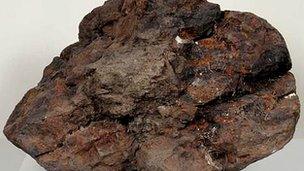Wilsford-cum-Lake doorstep meteorite 'biggest to fall in UK'
- Published

Experts said it would have taken at least four people to lift the meteorite
Mystery had always surrounded the origins of a 200lb (90kg) meteorite that had been on the doorstep of a Wiltshire house for more than 80 years.
Experts had wondered if the space rock had initially landed in another part of the world several thousand years ago and had been brought at some stage over to England
However, researchers now believe the 1.6ft (50cm) long rock may have landed 30,000 years ago closer to home - making it possibly the largest meteorite ever found in Britain.
What was known about the rock was that it had been on the step of Lake House near Wilsford-cum-Lake since the early-1900s.
But when the family, who wished to remain anonymous, wanted to sell property in 1991, they decided to take the rock, which they had always referred to as "grandfather's meteorite", to the Natural History Museum.
At the time, museum experts confirmed it as a meteorite but were unable to verify if it had been found in the UK.
It had been assumed the rock, which is four times larger than any other meteorites that had been previously found in the UK, had been collected by the family's grandfather on his travels abroad.
But Professor Colin Pillinger, from the Open University, who has been researching the meteorite's history for more than a year, said there was photographic evidence of the rock being on the steps of the house which predates the family.
He said he was now "99.9% certain" the meteorite had landed in the UK.
"It's very unusual to find a meteorite this big in Britain," he said.
"They are very unstable, they contain a lot of metallic iron which oxidises and the meteorite falls to pieces.
"So the only logical explanation of how such a big meteorite may have survived being on Earth for 30,000 years is that it fell on or near a glacier and was in a deep freeze for 20,000 years."
'Scavenging druids'
Professor Pillinger, famed for his work on the Beagle II Mars explorer, said he believed the low-humidity and freezing conditions would have protected the rock from weathering.
"Then along came some druids, scavenging on Salisbury Plain for strange or interesting stones, and it was picked up and used in a chalk mound," he said.

Professor Pillinger believes the giant meteorite was unearthed in an excavation of a burial mound
"And the 'reducing environment' of chalk - the anaerobic environment - would have prevented the iron from oxidising."
The giant fragment of asteroid is then thought to have been unearthed by a previous occupant of Lake House, who is known to have excavated several nearby burial mounds.
"He was an archaeologist and was digging every barrow up in sight trying to find treasure," said Professor Pillinger.
"And we think he got it out of a barrow and added it to his collection."
The meteorite, known as a common chondrite, is due to go on display at the Salisbury and South Wiltshire Museum in autumn.
Adrian Green, the museum's director, said there was still "a lot of debate" about how the rock came to be on the doorstep of Lake House.
"But it's not uncommon for exotic rocks to be built into burial mounds," he added.
"And it's still covered in chalk which is the bedrock of the landscape.
"And it's colossal - it would take four people to lift it - and it's not aesthetically pleasing, so common sense dictates that this has not been shipped from abroad at ridiculous cost and significant effort, but that it came from the UK."
- Published16 January 2012